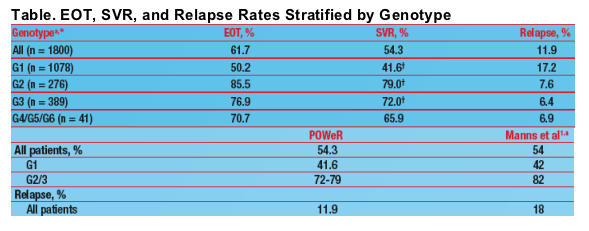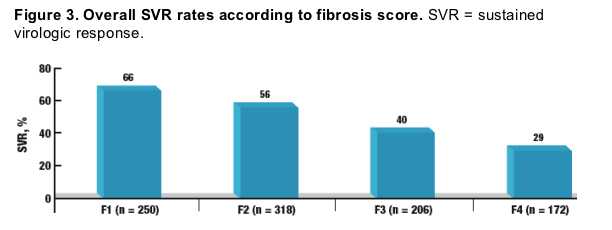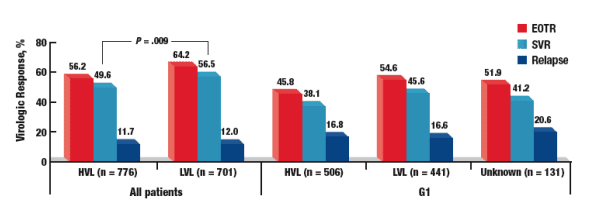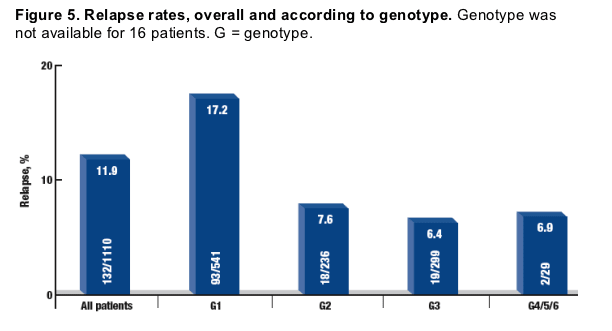 |
 |
 |
| |
Final Results of the Canadian POWeR (Pegetron Prospective Optimal Weight-Based Dosing Response) Program. Sustained Virologic Response (SVR) to Weight-Based Peginterferon alfa-2b + Ribavirin in a Large, Mixed, Community and Academic Observational Study
|
| |
| |
Reported by Jules Levin
AASLD, Nov 2-6, 2007, Boston, MA
Paul Marotta,1 Saya V. Feinman,2 Cameron Ghent,3 Linda Scully,4 Michael Varenbut,5 Jeff Daiter,5 Helga B. Witt-Sullivan,6 Jean Robert,7 Barbara Romanowski,8 John Farley,9 Nabil Abadir,10 Robert J. Bailey11
1London Health Sciences Centre, London, Ontario, Canada; 2Mount Sinai Hospital, Toronto, Ontario, Canada; 3University of Western Ontario, London, Ontario, Canada; 4Ottawa Hospital-Civic Campus, Ottawa, Ontario, Canada; 5Ontario Addiction Treatment Centers, Richmond Hill, Ontario, Canada; 6Hamilton Health Sciences General Site,
Hamilton, Ontario, Canada; 7Centre Sida Amitie des Laurentides, St. Jerome, Quebec, Canada; 8University of Alberta, Edmonton, Alberta, Canada; 9Private Practice, Vancouver, British Columbia, Canada; 10Schering-Plough Canada Inc., Kirkland, Quebec, Canada; 11Royal Alexandra Hospital, Edmonton, Alberta, Canada
Conclusions
⋅Successful treatment outcomes that match those from rigorous clinical trials can be achieved in routine clinical practice
⋅Despite poor predictive factors (advanced fibrosis and high baseline viral load) in this patient population, excellent SVR rates and low relapse rates with PEG-IFN alfa-2b plus RBV were attained in a real-life observational setting
⋅Observational trials include a more heterogeneous patient population than populations observed in controlled trials and provide useful information to practitioners and regulators on postapproval drug use
⋅Low virologic relapse rates were observed with combination therapy with PEG IFN alfa-2b plus weight-based RBV
Abstract
Background: To determine the impact of hepatitis C virus (HCV) genotype (G), baseline viral load, weight, and fibrosis stage on SVR rates in treatment-naive patients with chronic hepatitis C who were treated with weight-based peginterferon (PEG-IFN) alfa-2b and weight-based ribavirin (RBV) in a "real-life" observational setting. We report final SVR results from the POWeR program.
Methods: POWeR was an open-label observational trial conducted in academic and community clinics across Canada between 2002 and 2007. All patients received PEG-IFN alfa-2b (1.5 _g/kg/wk) plus RBV (800-1200 mg/day) for either 24 (G2 and G3) or 48 weeks (G1). SVR (defined as undetectable HCV RNA 24 weeks posttreatment) was stratified by genotype, baseline viral load, and fibrosis score.
Results: 1977 patients initiated treatment. Patients were excluded if they had undetectable HCV RNA at end of treatment but no 6-month follow up, had no treatment data available, or had HIV/HCV coinfection. This analysis was based on 1800 patients, including those who discontinued because of side effects, lack of response, or personal reasons. Most patients were infected with G1 (60%), followed by G3 (22%) and G2 (15%). Three percent of patients had G4/G5/G6 or no specified genotype. Baseline viral load was available in 1477 patients; 52% had high viral load (HVL; >600,000 IU/mL or 2-106 copies/mL). Liver biopsy specimens were available in 946 patients (53%), revealing ≦F2 fibrosis in 60% and F3-F4 fibrosis/cirrhosis in 40%.
SVR rates were higher in patients with minimal (≦F2) fibrosis than in those with advanced (F3-F4) fibrosis/cirrhosis (60% vs 35% P < .001) and in patients with low viral load than in those with HVL (57% vs 50% P = .009).
Baseline viral load and fibrosis score were negative predictive factors for SVR in G1 and G3 patients but not G2 patients.
Conclusions: Despite poor predictive factors (advanced fibrosis and HVL), excellent SVR rates and low relapse rates with PEG-IFN alfa-2b plus RBV may be attained in a real-life observational setting. Observational trials include a more heterogeneous patient population than those observed in controlled trials and provide useful information to practitioners and regulators on postapproval drug.

aThe Manns et al study used a flat-dose of 800 mg/d RBV and had 29% of patients with F3-F4 fibrosis, whereas the POWeR study used a weight-based RBV dosing schedule and had 40% of patients with F3-F4 fibrosis. Patients infected with HCV G2/3 were treated for 24 weeks in the POWeR study and for 48 weeks in the study by Manns et al.
≦F2 Versus F3-F4 fibrosis
⋅SVR rates were significantly higher for patients with minimal (≦F2) fibrosis than for those with advanced (F3-F4) fibrosis/cirrhosis (60% vs 35%, P < .001) (Figure 3)
⋅Fibrosis score was a negative predictive factor for SVR in patients infected with HCV G1 or G3 but not in patients infected with HCV G2

Low Versus High Baseline Viral Load
⋅SVR rates were significantly higher in patients with low baseline viral load (<600,000 IU/mL) than in those with high baseline viral load (57% vs 50% P = .009) (Figure 4)
⋅Baseline viral load was a negative predictive factor for SVR in patients with HCV G1 or G3 but not in patients with G2
⋅Consistently low (12%) overall relapse rates were observed among patients with either high or low viral load, indicating that baseline HCV RNA levels were not a predictor of overall relapse
Figure 4. SVR rates according to baseline viral load. HVL = high viral load (>600,000 IU/mL); EOTR = end-of-treatment response;
LVL = low viral load (≦600,000 IU/mL); G = genotype; SVR = sustained virologic response.

Relapse Rates
⋅11.9% (132/1110) of patients with an EOT response experienced relapse
⋅Relapse was more common in HCV G1-infected patients than in patients infected with HCV G2, G3, or G4/5/6 (Figure 5)

References
1. Manns MP et al. Lancet. 2001;358:958-965.
2. Fried MW et al. N Engl J Med. 2002;347:975-982.
|
| |
|
 |
 |
|
|